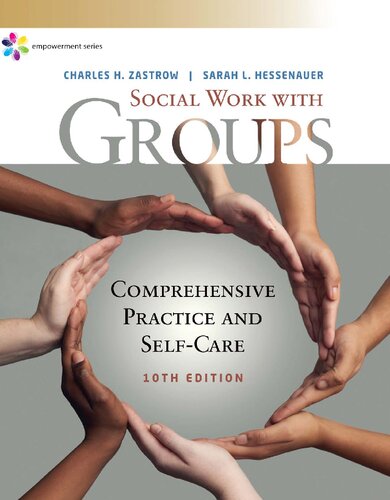(EBook PDF) Empowerment Series Social Work with Groups Comprehensive Practice and Self-Care 10th Edition by Charles Zastrow, Sarah Hessenauer 9798214352947 full chapters
$50.00 Original price was: $50.00.$25.00Current price is: $25.00.
Empowerment Series: Social Work with Groups: Comprehensive Practice and Self-Care 10th Edition by Charles Zastrow, Sarah L. Hessenauer – Ebook PDF Instant Download/DeliveryISBN: 9798214352947
Full download Empowerment Series: Social Work with Groups: Comprehensive Practice and Self-Care 10th Edition after payment

Product details:
ISBN-13 : 9798214352947
Author: Charles Zastrow, Sarah Hessenauer
Build effective group leadership skills with the experiential and self-evaluation exercises in SOCIAL WORK WITH GROUPS. The authors discuss topics that are central to understanding group leadership: stages of groups, group dynamics, verbal and nonverbal communication, types of groups, and diversity in groups. With support from this book, your classroom becomes a “lab” where you can experience what it’s like to work in and lead many kinds of groups. This edition also emphasizes self-care — with 30 strategies that you can use to improve your, and your clients’, well-being.
Empowerment Series: Social Work with Groups: Comprehensive Practice and Self-Care 10th Table of contents:
Chapter 1. Groups: Types and Stages of Development
Understand the History of Social Group Work
Historical Development of Group Work
Identify the Primary Types of Groups in Social Work
Types of Groups
Common Types of Treatment Groups
Initial Development of Groups
Stages of Groups
Understand Four Models of Group Development over Time
Models of Group Development over Time
Group Cohesion
Describe the Differences between Reference Groups and Membership Groups
Membership and Reference Groups
Breaking the Ice
Experiential Learning
Comprehend Guidelines on How to Conduct Classroom Exercises
Ethics and Guidelines for Conducting Exercises
Summary
Group Exercises
Competency Notes
Key Terms and Concepts
Chapter 2. Social Group Work and Social Work Practice
Conceptualize Social Work Practice
Definition of Social Work
Relationship between Social Work and Social Welfare
What Is the Profession of Social Work?
Generalist Social Work Practice
A Variety of Roles
A Systems Perspective
Understand the Medical Model Approach and the Ecological Approach to Assessing and Changing Human Behavior
Medical Model versus Ecological Model
Specify the Goals of Social Work Practice
Goals of Social Work Practice
A Problem-Solving Approach
Understanding the Strengths Perspective in Working with Clients
Strengths Perspective
Micro, Mezzo, and Macro Practice
Understand the Conceptualization of Social Work Practice that Is Presented in the Educational Policy Statement of the Council on Social Work Education for Baccalaureate Degree Programs and Master’s Degree Programs in Social Work
Knowledge, Skills, and Values Needed for Social Work Practice
Social Group Work as a Component of Social Work Practice
Summary
Group Exercises
Competency Notes
Key Terms and Concepts
Chapter 3. Group Dynamics: Leadership
Describe Five Major Approaches to Leadership
Approaches to Leadership
Identify Effective Group Leadership Functions, Roles, and Techniques
Leadership Roles
Understand that the Use of Power Is a Necessary Component of Group Functioning
Power and Influence in Groups
Describe Five Bases of Power in Groups, and Identify the Different Consequences of Using These Bases
Power Bases in Groups
Understand the Effects of Unequal Power in Groups
Effects of Unequal Power
Coleadership of a Group
Comprehend How to Start and Lead a Group
Guidelines for Forming and Leading a Group
Standards for Social Work Practice with Groups
Understand Strengths-Based Leadership
Strengths-Based Leadership
Summary
Group Exercises
Competency Notes
Key Terms and Concepts
Chapter 4. Group Dynamics: Goals and Norms
Set Personal and Group Goals in Groups
Setting Personal and Group Goals
Understand and Identify Hidden Agendas
Hidden Agendas
Establishing Group Goals
Comprehend the Differences between Competitive Groups and Cooperative Groups
Competition versus Cooperation
Apply the Nominal Group Approach
The Nominal Group Approach
Understand the Importance of Group Norms, and Comprehend How Norms Are Formed
Group Norms
Identify Group Pressures to Conform
Conformity
Identify Various Types of Hostile or Disruptive Group Members, and Comprehend How to Handle Disruptive Group Members
Types of Disruptive Behavior
Handling Disruptive Behavior
Reducing the Likelihood of Disruptive Behavior
Summary
Group Exercises
Competency Notes
Key Terms and Concepts
Chapter 5. Verbal and Nonverbal Communication
Understand a Model of Communication
A Model of Communication
Identify Factors That Interfere with the Communication Process
Perception
Self-Disclosure
Communicate More Effectively
How to Communicate Effectively
Have an Increased Understanding of Nonverbal Communication
Nonverbal Communication
Summary
Group Exercises
Competency Notes
Key Terms and Concepts
Chapter 6. Task Groups
Identify a Variety of Task Groups
A Variety of Task Groups
Comprehend How to Lead Task Groups
Guidelines for Leading Task Groups
Understand That One of the Major Functions of Task Groups Is Problem Solving
Problem-Solving Approach
Barriers to Effective Problem Solving
Utilize the Brainstorming Technique
Brainstorming
More Effectively Resolve Interpersonal Conflicts
Conflict
Techniques for Resolving Conflicts
Intergroup Conflict
Understand That a Second Major Function of Task Groups Is Decision Making
Decision Making
Approaches to Decision Making
Group versus Individual Decision Making
More Effectively Handle Groupthink
Groupthink
Summary
Group Exercises
Competency Notes
Key Terms and Concepts
Chapter 7. Working with Diverse Groups
Define Key Terms Involving Diversity
Definitions of Key Terms
Understand Stereotyping and Multiculturalism
Stereotyping and Multiculturalism: A Perspective
Identify Stereotypes and Preconceptions
Your Stereotypes and Preconceptions
Recognize the Importance of Social Workers Having In-Depth Knowledge of the Diverse Groups They Work With
Knowledge About Diverse Groups
Work More Effectively with the LGBTIQQ Population in Groups
Working with the LGBTIQQ Population in Groups
Posture of Reciprocity
Which Intervention Techniques Work?
Apply the Concepts of Ethnic-Sensitive Practice, Empowerment, and the Strengths Perspective
Ethnic-Sensitive Practice
Engage in Culturally Competent Practice
Culturally Competent Practice
Cultural Humility
Understand the RAP Framework for Leading Multiracial Groups
The RAP Framework Fob Leading Multiracial Groups
Apply Principles of Feminist Intervention in Social Work Practice
Feminist Intervention
Group Development Stages in Women’s Groups
Summary
Group Exercises
Competency Notes
Key Terms and Concepts
Chapter 8. Self-Help Groups
Define Self-Help Groups
Definition and Characteristics
Understand Two Classifications of Self-Help Groups
Classification of Self-Help Groups
Describe the Benefits of Self-Help Groups
Benefits of Self-Help Groups
Linkage with Social Workers
Comprehend How to Start a Self-Help Group and the Roles That Social Workers May Play within Self-Help Groups
Starting a Self-Help Group
Access Online Self-Help Groups
Online Self-Help Groups
Summary
Group Exercises
Competency Notes
Key Term and Concept
Chapter 9. Social Work with Families
Describe the Diversity of Family Forms
Diversity of Family Forms
Describe the Societal Functions of Families
Societal Functions of Families
Understand How to Use Two Family Assessment Techniques
Family Assessment
Comprehend Aspects of Families for Workers to Focus On
Aspects of Families for Workers to Focus On
Describe Family Problems and the Social Work Services Available to Families
Family Problems and Social Work Services
Summary
Group Exercises
Competency Notes
Key Term and Concept
Chapter 10. Organizations, Communities, and Groups
Understand the Close Relationships between the Terms Group and Organization
The Relationship between a Group and an Organization
Identify Several Models of Organizations
Models of Organizations
Survive, and Thrive, in an Agency
The Relevance of Theory X and Theory Y for Social Workers
Knopf’s Bureaucratic System Model and Theory X
Comprehend the Impact of Structure and Leadership Competency on Organizations
Organizational Effectiveness: Structure versus Leadership Competency
Understand the Relationships between the Terms Group, Organization, and Community
Communities, Organizations, and Groups
Analyze a Community
Identify Three Models a Social Worker Can Use in Seeking Constructive Community Changes
Models of Community Practice
Understand Asset-Based Community Development
Building and Sustaining Community Assets
Skills for Macro Practice
Summary
Group Exercises
Questions
Competency Notes
Key Terms and Concepts
Chapter 11. Educational Groups: With a Focus on Self-Care
Define an Educational Group
Educational Groups
Understand the Importance of Placing the Highest Priority on Self-Care
Define Self-Care
Importance of Managing Stress
Conceptualizing Stress
Long-Term Distress
Burnout
Better Manage Stress, Burnout, and Compassion Fatigue
Managing Stress
Overcoming Procrastination
Summary
Group Exercises
Competency Notes
Key Terms and Concepts
Chapter 12. Treatment Groups
Start, Lead, and End Treatment Groups
Starting, Leading, and Ending Treatment Groups
Preparation and Homework
Relaxing before Starting a Session
Cues upon Entering the Meeting Room
Seating Arrangements
Introduction
Clarifying Roles
Building Rapport
Exploring Problems in Depth
Exploring Alternative Solutions
Comprehend the Therapeutic Technique of Motivational Interviewing
Stages of Group Development
Ending a Session
Ending a Group
Co-Facilitating Treatment Groups
Legal Safeguards for Group Facilitators
Set Professional Boundaries with Clients
Setting Professional Boundaries with Clients
Understand the Therapeutic Factors of Treatment Groups
The Therapeutic Factors: What it is that Heals
Comprehend the Merits and Shortcomings of Evidence-Based Practice
Selecting Intervention Strategies: Evidence-Based Practice
Summary
Group Exercises
Competency Notes
Key Terms and Concepts
Chapter 13. Treatment Groups with Diverse and Vulnerable Populations
Comprehend the Process of Designing Treatment Groups for Current and Future Clients
Introduction
Group Work with Adolescents
Group Work with People who Have an eating Disorder
Group Work with Individuals Affected by Domestic Violence
Group Work with People who Are Grieving
Westberg Model
Grief Management in Groups
Group Work with Older Adults
Summary
Group Exercises
Competency Notes
Key Terms and Concepts
Chapter 14. Termination and Evaluation of a Group
Effectively Terminate a Group
Termination
Evaluation
Conduct a Process Evaluation of a Group
Process Evaluation
Conduct Three Approaches to Evaluating the Outcome of a Group
Outcome Evaluation
Summary
Group Exercises
Competency Notes
Key Terms and Concepts
People also search for Empowerment Series: Social Work with Groups: Comprehensive Practice and Self-Care 10thL
examples of social work groups
examples of empowerment in social work
social work group topics
types of empowerment in social work
natural groups in social work
Tags:
Empowerment Series,Social Work,Groups,Comprehensive Practice,Self Care,Charles Zastrow,Sarah Hessenauer
You may also like…
Education Studies & Teaching - School Education & Teaching
Empowerment Series: An Introduction to the Profession of Social Work 6th Edition
Uncategorized
Uncategorized
Empowerment Series: Essential Research Methods for Social Work 4th Edition, (Ebook PDF)
Uncategorized
Empowerment Series: Direct Social Work Practice: Theory and Skills 10th Edition, (Ebook PDF)
Politics & Philosophy - Social Sciences
Introduction to Social Work and Social Welfare 12th Edition Charles Zastrow
Uncategorized
Empowerment Series: An Introduction to the Profession of Social Work 5th Edition, (Ebook PDF)












